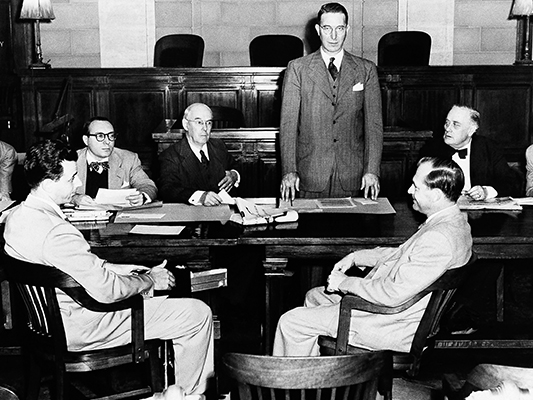Estes Kefauver

Born: July 26, 1903, Madisonville, Tennessee
Died: August 10, 1963, Bethesda, Maryland
Nicknames: Big Stuff, Kef
Associations: U.S. Senate, Kefauver Committee
In 1950, there wasn’t a clear public consensus that a national organized crime syndicate was a big problem or, indeed, that it even existed. Certainly there was evidence that there was, or had been, organized crime activity in Chicago, New York and a few other cities, but across the country? Some experts, such as FBI Director J. Edgar Hoover, denied the Mafia’s existence.
A series of hearings held by a special U.S. Senate committee in 1950 and 1951 changed that perception. The hearings made it clear to a lot of people that there was a national Mob, and that it had a lot of power. Those hearings became known as the Kefauver Hearings after the committee’s chairman, Senator C. Estes Kefauver of Tennessee.
The committee conducted 27 hearings in 14 cities, including one day in Las Vegas on November 15, 1950, in the federal building downtown (now The Mob Museum). Several well-known Las Vegas residents testified, including Moe Sedway, manager of the Flamingo Hotel; Wilbur Clark, front man for the Desert Inn; and Clifford Jones, Nevada’s then lieutenant governor.
The hearings were popular nationwide in movie newsreels, on the radio and in the hot new technology of the time — television. Gangsters, politicians and others testified about their involvement with or knowledge of criminal activities. Some “pled the Fifth,” citing their constitutional right not to incriminate themselves.
The Senate committee’s first televised hearing was broadcast from New Orleans. That broadcast was so popular that television stations in other cities asked to broadcast the hearings as well. The televised hearings were so novel and interesting that they became a pop culture event. Households came to a standstill while the hearings were on. Movie theaters offered free showings. The hearings were seen by as many as 30 million people, or more than watched baseball’s World Series on television that year.
Before the Kefauver Hearings, many people had little idea that organized crime was exactly that — organized. They knew there were people booking numbers, stealing or killing, but they didn’t know those people were working with people in other parts of the country to coordinate and control large rackets.
While there were few laws passed or people arrested directly because of the hearings, the public could no longer deny that crime syndicates existed. Law enforcement agencies intensified their crackdowns on the Mob around the country. As a result, some crime bosses decided to invest in the only state in which gambling was then legal: Nevada.
The hearings elevated Senator Kefauver to national prominence, with a cover story in Time magazine and many other profiles. He ran twice for president, and was picked as the Democratic Party’s nominee for vice president in 1956.
Kefauver served 10 years in the House of Representatives, from 1939-49, before serving in the Senate from 1949 until his death. His crusade against organized crime earned him guest appearances in Hollywood movies, and he has a fictional high school named after him, C. Estes Kefauver High School of the equally fictional Dacron, Ohio, in the National Lampoon 1964 High School Yearbook Parody.




